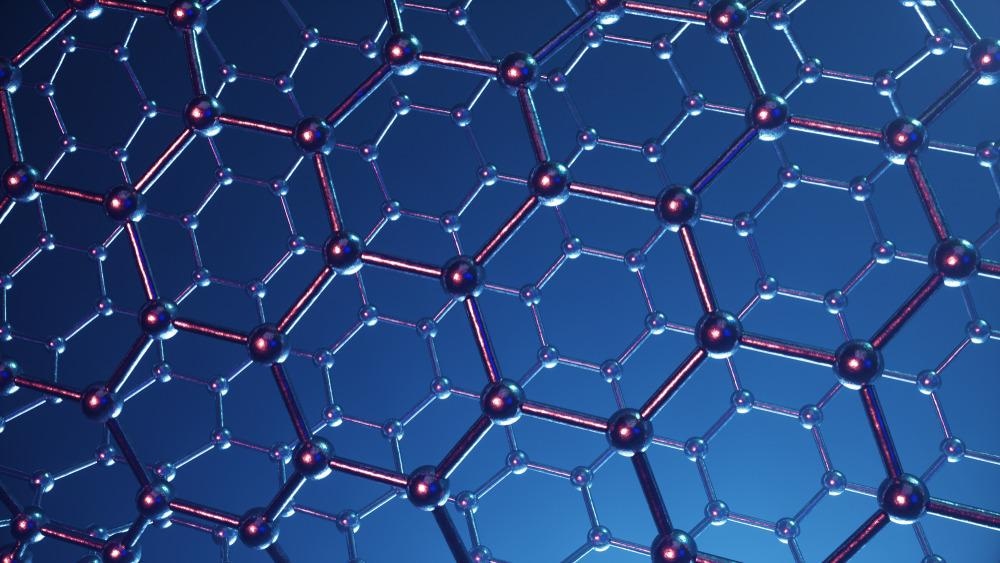New research published in the journal Chemistry of Materials aims to overcome the challenges of producing 2D materials on a large scale by introducing a novel method for the nucleation and growth of graphene.

Study: Self-Assembly Graphene Arrays on a Liquid Cu–Ag Alloy. Image Credit: Rost9/Shutterstock.com
Owing to its unique properties and application potential across an extensive range of industries, graphene has continually attracted much attention since its discovery in 2004. Furthermore, interest has also piqued in relation to other self-assembly two-dimensional materials possessing a perfect atomic planar structure.
However, issues experienced when fabricating large-sized 2D crystal arrays, such as precise manipulation of nucleation, have restricted industrial-scale production of two-dimensional materials. Now, a team of researchers in China have recently demonstrated a successful method for precise engineering of nucleation and growth of graphene using a liquid Cu-Ag (copper and silver) alloy as a catalyst.
The team believes that their method shows good potential for high-quality growth of a graphene array on a liquid alloy, and could break new ground when it comes to industrial production and commercial applications.
Graphene Arrays
Using graphene as an example and starting point for their research, the team led by Lin Li, Dechao Geng, and Wenping Hu, were seeking to develop an effective method to overcome current difficulties experienced when attempting to engineer and grow two-dimensional materials.
Graphene arrays in particular have excellent application potential and can act as conductive interconnection in electronic circuits for barrier-free contacts. Graphene can also attach its own unique properties for use in integrated electrical devices such as photodetectors.
Other potential uses of graphene include application in medicine and biotechnology, ultrasensitive sensors, multifunctional composites and coatings, membranes, energy harvesting and storage, and even wearable and superfast electronics.
Read More: Liquid Crystals with Carbon Nanotubes for Electro-Optical Applications
Like other two-dimensional materials, which include monolayer materials such as MXenes, phosphorene, bismuthene, etc., graphene is well-known for its outstanding physical and chemical properties which can have a significant impact on the advancement of various nanotechnologies. Therefore, developing new production methods for such materials will have a wide-ranging impact across the industry as a whole.
Liquid Catalysts
Typically, there are two main strategies that have been developed for the growth of two-dimensional materials one of which includes decreasing nucleation, however, this is a long-time process which is an extremely time-consuming approach.
A second multispeed approach is much faster but requires a series of complex surface processing steps as well as the inclusion of a single-crystal metal substrate, which can be expensive. However, the Chinese team opted for a chemical vapor deposition (CVD) method which uses a catalyst to shape the 2D materials.
Using catalysts in the synthesis of graphene has been previously explored, but demonstrated some limitations, “Traditional catalysts possess a great challenge in achieving the growth of highly uniform and high-quality self-assembly 2D materials,” says Professor Wenping Hu, co-author and researcher at the Department of Chemistry, School of Science, Tianjin University, China.
However, the use of alloy catalysts has proven to be more successful in synthesizing highly oriented and monolayer graphene due to the excellent properties demonstrated by the combination of different metals such as a solid Cu-Ag alloy.
In addition, multiseed growth which belongs to the second approach can be realized by controlling the surface engineering of the alloy catalysts and reducing the cost
Professor Wenping Hu, co-author and researcher at Department of Chemistry, School of Science, Tianjin University, China
However, the Chinese team was able to go one step further and successfully show, for the first time, that when using a liquid Cu-Ag alloy catalyst the CVD method shows great potential in controllability over size layer, crystallinity, and morphology of graphene.
Precision Engineering
To characterize their results, the team obtained optical images by applying scanning electron microscopy (SEM), atomic force microscopy (AFM), and Raman Spectroscopy. They found that the graphene arrays exhibited outstanding uniformity and excellent quality.
“With the introduction of the liquid Cu−Ag alloy, precise engineering of nucleation and growth of graphene has been achieved. Moreover, by properly modulating the composition of the Cu−Ag alloy, the shape evolution of graphene single crystals is also detected and thus results in controllable formation of round-shaped graphene arrays,” explained Hu.
Furthermore, the as-proposed theoretical calculations and measurements made throughout the study also demonstrated high consistency for the method in parallel with the experimental results. Thus, thanks to Hu and his team, effective precision engineering of two-dimensional materials, including graphene, at a large scale could soon become a reality.
References
Yixuan Fan, Menghan Li, Xiangzheng Jia, Lin Li, Qing Zhang, Enlai Gao, Dechao Geng, and Wenping Hu. (2021). Self-Assembly Graphene Arrays on a Liquid Cu–Ag Alloy. Chemistry of Materials Article ASAP DOI: 10.1021/acs.chemmater.1c02390
Disclaimer: The views expressed here are those of the author expressed in their private capacity and do not necessarily represent the views of AZoM.com Limited T/A AZoNetwork the owner and operator of this website. This disclaimer forms part of the Terms and conditions of use of this website.